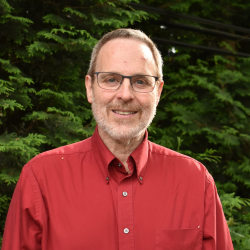
“Interreligious experience” is an incomplete—and even ambiguous—phrase. The experience itself can take many forms, from having a respectful, open-hearted dialogue with someone of a different faith to experiencing spiritual growth that comes from worshiping together and sharing our beliefs and traditions.
But the term interreligious experience can also captures tense moments of misunderstanding between people of different religious backgrounds. We live in an increasingly multicultural society, a world rife with suspicion and ignorance. That suspicion and ignorance can lead to encounters in which people single each other out, confront each other, and create conflict. These negative interreligious experiences have been much on my mind lately. Several years ago, I was an unwilling participant in just such a fraught encounter, one in which I intervened in a way that seemed helpful at first, but in retrospect laid bare my own ignorance and unexamined prejudices.
It happened on a packed commuter train during the first blush of See Something/Say Something vigilance about terrorism and public safety. We were a typical mix of morning riders that day, several of whom appeared to be Orthodox Jewish men distinguished by their dress and Hebrew scriptures.
Midway through the trip, one of the men stood, wrapped himself in a shawl and strapped small boxes to his wrist and forehead. He began to move his lips as if speaking to himself, bowing slightly again and again as he did so.
As an Episcopal layman, I’m no expert in Judaism, but I recognized that the man was praying in accordance with religious tradition. He was as private as one could be in a crowded, public place, interacting with no one but God in his morning observance.
But my seatmate, a woman in business dress, grew more and more agitated as the man’s prayers went on. At one point, she asked me in a low voice whether I saw what he was doing—and if we should call the conductor. Her unspoken implication seemed to be that what we were witnessing could be the precursor to a violent attack aboard the train.
I did my best to reassure her, explaining that this was someone praying in a particular Jewish tradition, something I’d seen before, and that there was no need to call the conductor. The man eventually finished his prayers and returned to his seat. The train pulled into the station in Washington, D.C., and we all prepared to get off.
My seatmate, whose name I never knew, seemed embarrassed by the incident, apologetic about her reaction and by what might have escalated into outright confrontation. I tried to reassure her again before we parted.
What I failed to share—what I could fully admit only in retrospect—was that I’d had a flash of uncertainty and nervousness myself. Though I dismissed that reaction almost at once, I’d also internalized anxiety about the connection between religion and terrorist violence, and in a way that, for a single, irrational moment, made our fellow commuter a target of suspicion.
We all wrestle with our biases, conscious or unconscious, and with our innate reaction to the “other,” however we may define it. And in our increasingly diverse society, we need to interact more often with those whose traditions and beliefs manifest themselves in ways different from our own.
Over time, we’re likely to grow more familiar with others’ beliefs and practices. But simply witnessing them doesn’t mean understanding them. And a lack of understanding leaves a vacuum that can be filled with false assumptions and our own prejudices. This can poison our interactions, hurt others, and wall us off from what should be fruitful ground for true interfaith dialogue.
Learn, Respect, Engage
Take this incident, for example. I learned from Ben Sax, ICJS Jewish Scholar, at a meeting of the Congregational Leaders Fellowship more about the prayer tradition I’d witnessed previously with only superficial understanding.
The young man engaged in prayer—known as tefillah in Hebrew or davening in Yiddish—was making space in his day to fulfill his duty for morning prayer, regardless of the setting. Cloaking himself in his shawl, affixing prayer boxes to his wrists and forehead, and speaking and moving in a ritual way all created a sacred space for him in mundane, secular surroundings.
This was the opposite of something to fear. In using God’s words in the form of prayer to create a holy space aboard a crowded train, this observant individual was in effect blessing us all, his fellow riders, whether we were aware of it or not. That he did so regardless of the reaction it might draw is a testament to his devotion, and should have been an inspiration had we fully understood what we were witnessing.
None of this occurred to me at the time. It’s only after reflection—and a recognition of how much I need to learn—that I realize I’ve been missing opportunities for meaningful interfaith experience in the course of my own daily interactions.
It’s a cautionary tale for all of us. We may overlook or misunderstand what we see when confronted with the unfamiliar. In doing so, we may fail to appreciate the sacred right in front of us. Even worse, we may leap to conclusions that lead to conflict, division, or damage to those with whom we share so much.
I wish now that I’d recognized and honored—in the moment—the devotion of the young man at prayer that morning and had taken it to heart as encouragement for my own call to prayer. And in talking with the woman I sat with, I wish I’d shared my flash of anxiety rather than smugly distancing myself, pretending to an understanding I didn’t really have.
In the end, I’ve realized, I’m just a fellow traveler in a world sorely in need of learning and understanding. I pray, in the words of Psalm 51, v. 6: “You insist on sincerity of heart; in my inmost being teach me wisdom.”
 Mark Bomster is a member of Cathedral of the Incarnation and was a member of the 2023 ICJS Congregational Leaders Fellowship. Learn more about the ICJS Congregational Leaders programs here.
Mark Bomster is a member of Cathedral of the Incarnation and was a member of the 2023 ICJS Congregational Leaders Fellowship. Learn more about the ICJS Congregational Leaders programs here.
Opinions expressed in blog posts by the ICJS Congregational Leader Fellows are solely the author’s. ICJS welcomes a diversity of opinions and perspectives.